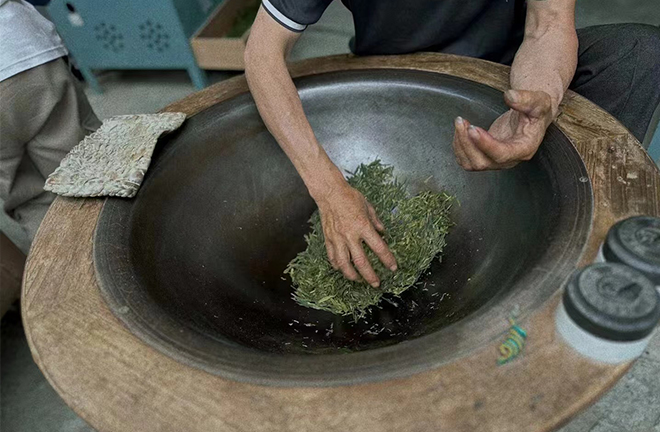Constructing aesthetic discourse for intangible cultural heritage

In 2022, traditional tea processing techniques and associated social practices in China were inscribed on the UNESCO Representative List of the Intangible Cultural Heritage of Humanity. Photo: Ren Guanhong/CSST
While humans undoubtedly attach great importance to cultural heritage, the focus has long been on the preservation and study of its more tangible aspects. It was not until the late 20th century, and particularly the early 21st century, that attention gradually began to shift towards intangible cultural heritage worldwide, which was marked by the adoption of the Convention for the Safeguarding of the Intangible Cultural Heritage by UNESCO. Consequently, theories relevant to intangible cultural heritage have flourished in disciplines such as history, anthropology, and sociology. However, intangible cultural heritage remains relatively marginalized in the field of aesthetics.
Both Chinese and Western classical aesthetic theories prioritize aesthetic activities that transcend daily life and aim to elevate the human spirit, emphasizing aesthetic values with universal significance. Intangible cultural heritage, characterized by its distinct folkloristic and local nature, is largely represented by artistry and craftsmanship. Its aesthetic implications are often centered on folklore, making it difficult to fit within the realm of conventional aesthetics.
Tangible cultural heritage exists as solid and static objects, whereas intangible cultural heritage is characterized by embodied practice and “living inheritance” that integrates subjects with objects. While tangible cultural heritage is already detached from specific social and historical contexts to be considered from the “non-utilitarian” perspective of conventional aesthetics, aesthetics associated with intangible cultural heritage are ongoing, dynamic, and hardly detachable from utilitarian aspects. Such “unfinishedness” and “impurity” contradict conventional aesthetics to some extent.
How do cultural phenomena that transcend the presupposition of “beauty” relate to aesthetics? This question should be addressed not only to promote the inheritance and preservation of intangible cultural heritage, but also to tackle the global cultural crisis that emerged in the 20th century and construct disciplinary discourse for aesthetics. This article suggests constructing a new aesthetic discourse for intangible cultural heritage in the new era along three dimensions: the displacement of aesthetic objects, the evolution of aesthetic subjects, and the development of aesthetic approaches.
In recent years, with the creative transformation and innovative development of China’s fine traditional culture, intangible cultural heritage rooted in different regions, professions, demographic groups, and even individuals has been rediscovered through communication empowered by media convergence, yielding brilliant results. This demonstrates the cultural charm of intangible cultural heritage and its effects via mass communication. The emergence and development of intangible cultural heritage are closely linked to its communities and regions of origin. At the same time, rich intangible cultural heritage is a valuable asset to human cultural diversity.
In terms of aesthetic objects, aesthetic research can integrate intangible cultural heritage with the communities that underlie its development, view them as dynamic objects of aesthetic contemplation, and engage in theoretical interpretation of folk and local aesthetic phenomena by placing the aesthetic construction process of “subject-skills-community” interactions at the center. The aesthetic value of intangible cultural heritage lies not in static inherent properties, but in the interactive scenarios wherein imagery symbols are generated and meaning is produced and conveyed by means of specific skills.
In terms of aesthetic subjects, aesthetic research should probe the multiple roles of subjects in the inheritance and preservation of intangible cultural heritage. In aesthetic activities involving intangible cultural heritage, aesthetic subjects are not detached observers; rather, they can assume the role of practitioners, protectors, and inheritors.
Regarding aesthetic approaches, aesthetic research can start with the reproduction and innovation of traditional culture to evoke empathy in aesthetic subjects. An interactive channel between history, the present, and even the future can be effectively constructed through “living inheritance” which is unique to intangible cultural heritage. Aesthetics thus becomes an artistic practice that connects skills and subjective feelings, providing theoretical foundations to overcome its conventional limitations.
Through the lens of communication studies, whether in physical or media-based space, the audience, inheritors, and skills of intangible cultural heritage are co-present and capable of emotional interaction. This can effectively facilitate the audience’s perception and understanding of the traditional cultural atmosphere, thereby instilling in them a sense of belonging and identity with their fine national culture.
Intangible cultural heritage not only embodies specific geographical environments, livelihoods, interactions among ethnic groups, and social relations, but also consists of the practical wisdom, emotional resonance, ethical consensus, and cultural genes of the communities. The Convention for the Safeguarding of the Intangible Cultural Heritage aims to achieve “living inheritance” of diverse cultures in a process of mutual appreciation and mutual learning, ensuring the vitality of intangible cultural heritage.
In light of the goal of preserving cultural diversity and building a new global cultural ecosystem, the crucial cultural value of intangible cultural heritage lies in cultural sharing, harnessing new potentials for its own development, and establishing a communication framework for mutual appreciation and mutual learning with other cultures. The innovative construction of aesthetic discourse also requires incorporating intangible cultural heritage into aesthetic research and endeavoring to build an expansive, diverse, and interactive cultural ecosystem.
Wang Yuan is an editor at the journal Dongyue Tribune sponsored by Shandong Academy of Social Sciences.
Edited by WANG YOURAN
